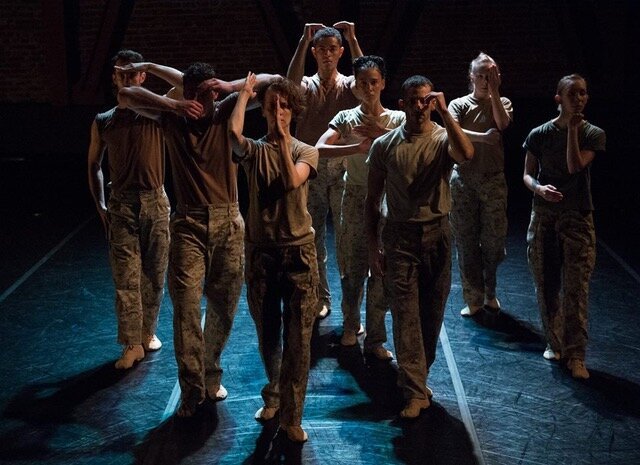Of Girls and Men: Ballet's Gender Binary Problem
Imagery dancers in Val Caniparoli’s “Triptych” (SKETCH 3, 2013). Photo by David DeSilva.
This is one instance of gender neutral costuming in Imagery’s SKETCH history. Fun fact: dancers removed all makeup for this piece--a rarity in concert dance--and audiences were treated to a highly personal, up close, raw view of this diverse group of dancers.
[ Image description: Eight dancers face the audience in a triangular formation. They wear tan army fatigue pants, neutral colored t-shirts, and tan dance boots. Each dancer strikes a unique gestural pose with their hand framing their faces. ]
In ballet school, girls do one set of things and boys do another set of things.
In ballet companies, “girls” do one set of things and men do another set of things.
It should come as no surprise that these disparities remain--and in fact become even more stark--when it comes to positions of leadership in the ballet world. At Imagery, our fearless female leader has confronted gender bias and inequity head on from the very start in order to craft awareness and shape change for women as leaders in ballet. These values are woven into the fabric of the company and manifest explicitly in our programming, curation, and steadfast commitment to pay equity. But turning up the volume on female voices in ballet is just the beginning. We still have a long way to go if we are to achieve real justice for people of all genders in this rarefied and highly gendered art form.
As millennials and subsequent generations come of age in the 21st century, new light is being shed on the inherent fallacies in existing binary structures of gender identity and expression in our society. Transgender and non-binary people are finally able to come out of the shadowy margins and begin to advocate for their right to legitimacy and representation. While the times are (slowly) changing, ballet’s status as a historically Eurocentric, heteronormative art form makes it particularly resistant to innovation.
Unfortunately, ballet’s attitudes and aesthetics tend to lag a couple centuries behind the current discourse. Even today, “girls” (who it seems never become women) are still largely expected to be as slim, pretty, and demure as the characters they portray in 19th century classics; they are identical and disposable, pitted against one another to fulfill a perpetually unattainable standard of hyper-feminized beauty and perfection. Conversely, ballet’s men are strong, traditionally masculine, and consummately in control, whether they’re lifting, turning, and manipulating their female partners or calling the shots at the front of the studio or in the boardroom. They too are held to rigid standards of gender expression, but their inherent power lies in the value created by their scarcity and the freedoms and privileges permitted as a result of this perceived value. The culture created around these ideas systematically disempowers women by relying on and adhering to actively unfeminist, patriarchal, and paternalistic standards and principles that are, in the end, damaging to people of all genders.
The cracks in the system have existed for far too long. It’s time to explode the gender binary in ballet. It’s time for a deep cultural and aesthetic shift to re-envision the standards and ideals of ballet beyond gender. It’s time to enact systemic changes that allow us to encompass the individual, actualized, modern identities of all people in the full range of human expression. After all, dance is a living, breathing art form that depends on these modern minds and bodies to create and perform the work itself. As these minds and bodies change, the work itself must also necessarily change in order to remain relevant. Though there is still much to overcome in order to expand and redefine the deeply ingrained norms of ballet’s ethos and aesthetics, we have nothing to lose and everything to gain in this effort.
The cultural and aesthetic shifts required to enact true changes in gender perception begin on many fronts, including dance education, training, choreography, performance, and curation. As a curating company, choreographic laboratory, and vehicle for Amy Seiwert’s own work, Imagery is always seeking to expand the ideas and identities we can embody through ballet vocabulary. As a ten-year veteran of the company, I have experienced a range of expressions and encountered new strengths and modalities through the truly collaborative efforts of a wide-ranging team of dancers, choreographers, and collaborators. I’ve had the pleasure of establishing deep and meaningful partnerships with male dancers, many of whom, in a traditional ballet mindset, would have been dubbed “too short” or “too weak” for a tall, muscular woman like me. I’ve danced tenderly and powerfully with women in ways that celebrated the strength of our differences. I’ve danced virtuosically alongside men, holding them to every step both in and out of pointe shoes. I have often been challenged to use my body in ways that pushed the boundaries and conventions of my training in classical ballet technique and partnering. I’ve consistently felt my voice empowered at every level of the creative process as we collaborated to build something new as a reflection of our individual strengths and qualities. And most importantly, I’ve had a part in creating and telling stories that transcend gender to reveal something essential of our shared humanity.
Stay tuned for more as we explore the complex and multifaceted dynamics surrounding gender identity and expression in ballet.
